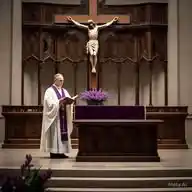
DAILY CATHOLICS MASS READINGS
June 14, 2025 at 03:33 PM
*THE MOST HOLY TRINITY SUNDAY*
Trinity Sundayis celebrated in all denominations of the Western liturgical churches: Latin Catholic, Lutheran, Anglican,Reformed Continental Reformed, Presbyterian,Congregationalist,and Methodist.
*History*
In the early Church, no special Office or day was assigned for the Holy Trinity. When the Arian heresy was spreading, the Fathers prepared an Office with canticles, responses, a Preface, and hymns, to be recited on Sundays. In the Sacramentary of Gregory the Great there are prayers and the Preface of the Trinity. During the Middle Ages, especially during the Carolingian period, devotion to the Blessed Trinity was a highly important feature of private devotion and inspired several liturgical expressions. Sundays are traditionally dedicated to the Holy Trinity.
The Micrologies written during the pontificate of Gregory VII list no special Office for the Sunday after Pentecost, but add that in some places they recited the Office of the Holy Trinity composed by Bishop Stephen of Liège (903–920). By others the Office was said on the Sunday before Advent. Alexander II (1061–1073), refused a petition for a special feast on the grounds that such a feast was not customary in the Roman Church which daily honoured the Holy Trinity by the Gloria Patri, etc., but he did not forbid the celebration where it already existed. A new Office had been made by the Franciscan John Peckham, Canon of Lyons, later Archbishop of Canterbury (d. 1292).
John XXII (1316–1334) ordered the feast for the entire Church on the first Sunday after Pentecost and established it as a Double of the Second Class. It was raised to the dignity of a primary of the first class, 24 July 1911, by Pope Pius X( Acta Ap. Sedis, III, 351) Since it was after the first great Pentecost that the doctrine of the Trinity was proclaimed to the world, the feast becomingly follows that of Pentecost.
*Roman Catholicism*
In the Roman Catholic Church, it is officially known as the Solemnity of the Most Holy Trinity. Prior to the reforms of the Second Vatican Council, it marked the end of a three-week period during which church weddings were forbidden. The period began on Rogation Sunday, the fifth Sunday after Easter. The prescribed liturgical color is white.
In the traditional Divine Office, the Athanasian Creed (Quicumque vult) is said on this day at Prime. Before 1960, it was said on all Sundays after Epiphany and Pentecost which do not fall within Octaves or on which a feast of Double rank or higher was celebrated or commemorated, as well as on Trinity Sunday. The 1960 reforms reduced it to once a year, on this Sunday.
In the 1962 Missal, the Mass for the First Sunday After Pentecost is not said or commemorated on Sunday (it is permanently impeded there by Trinity Sunday), but is used during the week if the ferial Mass is being said.
The Thursday after Trinity Sunday is observed as the Feast of Corpus Christi. In some countries, including the United States, Canada, and Spain, it may be celebrated on the following Sunday, when the faithful are more likely to attend Mass and be able to celebrate the feast.
🙏
4